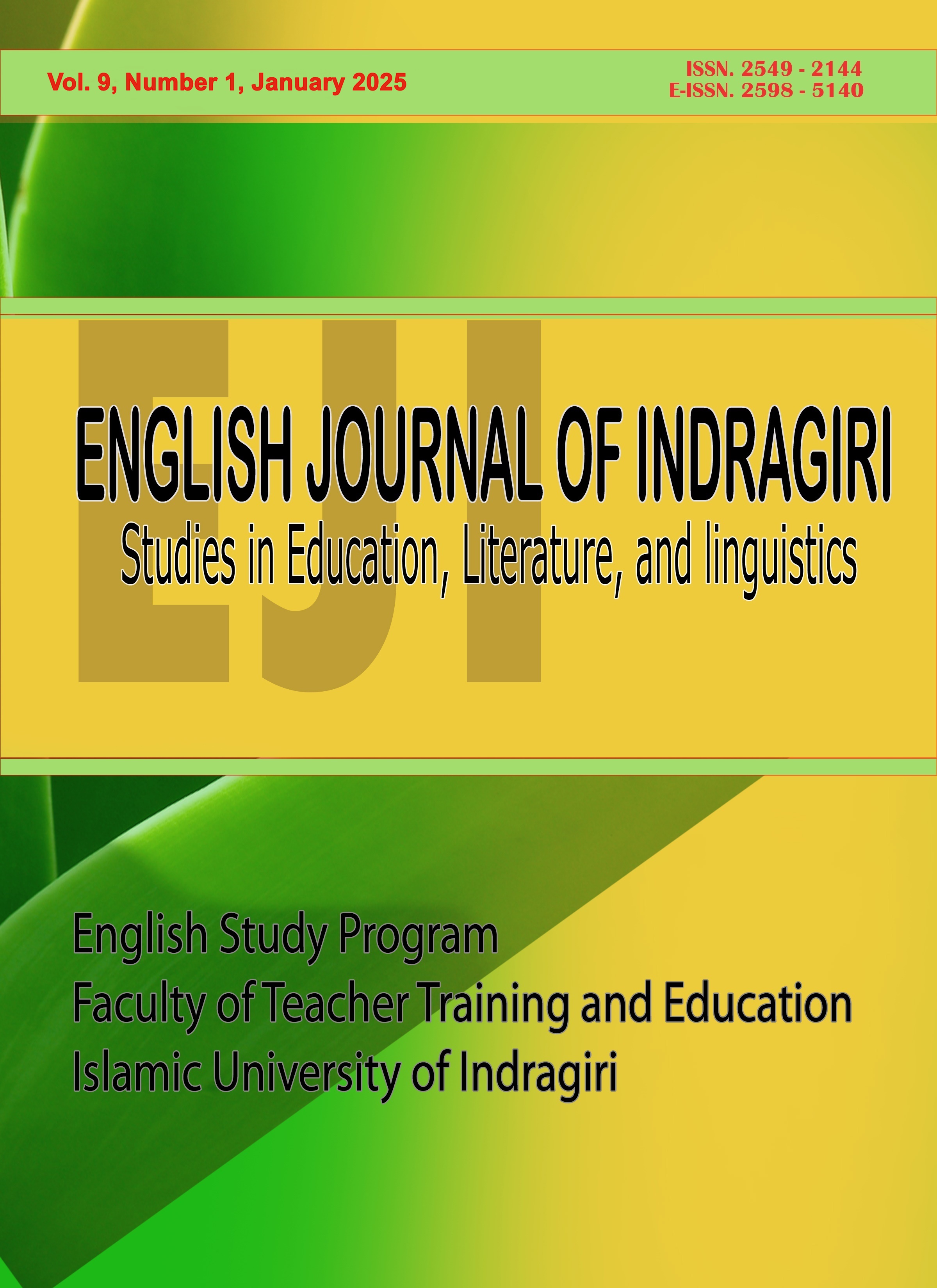Undergraduate Students’ English Pronunciation Anxiety (EPA) In Pronunciation Class at English Education Department Wiralodra University
DOI:
https://doi.org/10.61672/eji.v9i1.2757Keywords:
Pronunciation, Pronunciation Anxiety, EPA, Undergraduate StudentsAbstract
One of the difficulties faced by non-native speakers when learning English is pronouncing sounds or words. In this case, there are many kinds of factors or problems. One of them is the feeling of anxiety when speaking English. One of them is English pronunciation anxiety. The purpose of this study is to determine the level of English Pronunciation Anxiety (EPA) of undergraduate students. The second is to determine the indicators of English Pronunciation Anxiety (EPA) of undergraduate students in pronunciation classes. This study used qualitative method and case study as a research design. The participation of this study of second-semester students in the 2022/2023 academic year, with 18 students. Overall, The researcher examined students' anxiety levels in English pronunciation, identifying two levels: "mild" and "moderate." Eight students experienced "mild" anxiety, while ten experienced "moderate" anxiety. The moderate level of anxiety indicated significant anxiety and self-consciousness. The higher scores indicated a higher level of concern about their pronunciation, reflecting a more substantial anxiety and respect for their ability. The study found that undergraduate students at Wiralodra University experienced moderate to high levels of English pronunciation anxiety. This anxiety was attributed to self-consciousness and concern about their pronunciation abilities. The research suggests that educators can use relaxation techniques, constructive feedback, and language-focused activities to manage anxiety. Curriculum developers should incorporate pronunciation-focused activities and improve teacher training programs. Further research is needed to explore the impact of cultural, linguistic, and educational backgrounds on pronunciation anxiety.
References
Adeline, F. D. (2020). Pronunciation problems of Indonesian EFL learners in pronouncing/g/sound. EDUCAFL: Journal of Education of English as Foreign Language, 3(1), 1-17. https://doi.org/10.21776/ub.educafl.2020.003.01
Ahsan, M., Asif, M., Kaukab, A., Zafar, M., & Naeem, M. (2020). Anxiety as an English pronunciation barrier in multilingual classroom: A case study of southern Punjab (Pakistan). International Journal of English Language and Literature Studies. https://doi.org/10.18488/journal.23.2020.94.305.314
Al-Atabi and Al-Noori. (2020). Classroom Anxiety. University of Bagdad, 341774611. DOI: 10.13140RG.2.2.30307.99366
Al-Rubaat, A. M., & Alshammari, H. A. (2020). Analysis of phonetic and phonological constraints of Saudi EFL learners. English Language Teaching, 13(1), 63-72.
doi: 10.5539/elt.v13n1p62 https://doi.org/10.5539/elt.v13n1p62
Alshehri, A. (2020). Perception of the English phonotactics by Saudi English majors: A comparative study. Arab World English Journal, 11(4), 207-222. https://doi.org/10.24093/awej/vol11no4
Antaris, I., & Omolu, F. A. (2019). Factors affecting pronunciation difficulties of 8th-grade students of MTSN Palu Barat. Journal of Foreign Language and Educational Research, 2 (2), 10-19 https://doi.org/10.31934/jofler.v2i2
Bandura, A. (1997). Self-efficacy: The exercise of control. New York, NY: Freeman. https://www.academia.edu/28274869/Albert_Bandura_Self_Efficacy_The_Exercise_of_Control_W_H_Freeman_and_Co_1997_pdf
Baran-Łucarz, M. (2013). Phonetics learning anxiety–results of a preliminary study. Research in Language, 11(1), 57-79.http://dx.doi.org/10.2478/v10015-012-0005-9
Baran-Łucarz, M. (2014). The link between pronunciation anxiety and willingness to communicate in the foreign-language classroom: The Polish EFL context. Canadian Modern Language Review, 70(4), 445-473. http://dx.doi.org/10.3138/cmlr.2666
Baran-Łucarz, M. (2014). Pronunciation anxiety and willingness to communicate in the foreign language classroom. Concordia Papers in Applied Linguistics, 5, 36-49. TY - JOUR https://www.researchgate.net/publication/276887286_The_Link_between_Pronunciation_Anxiety_and_Willingness_to_Communicate_in_the_Foreign-Language_Classroom_The_Polish_EFL_Context/citation/download
Baran-Łucarz, M. (2017). FL pronunciation anxiety and motivation: Results of a mixed-method study. At the crossroads: Challenges of foreign language learning, 107-133.Eysenck, M. W. (2013). Anxiety: The cognitive perspective. Psychology Press. DOI:10.1007/978-3-319-55155-5_7
Creswell, J. W. (2013). Qualitative inquiry and research design: Choosing among five approaches. https://www.researchgate.net/publication/232577017_Qualitative_Inquiry_Research_Design_Choosing_Among_Five_Approaches
Creswell, J.W., & J, David Creswell. Research design: qualitative, quantitative, and mixed methods approaches / John W. Creswell, PhD, Department of Family Medicine, University of Michigan, and J. David Creswell, PhD, Department of Psychology. https://www.ucg.ac.me/skladiste/blog_609332/objava_105202/fajlovi/Creswell.pdf
DeMartini, J., Patel, G., & Fancher, T. L. (2019). I have generalized anxiety disorder.
Annals of Internal Medicine, 170(7), ITC49-ITC64. https://doi.org/10.7326/AITC201904020
Derwing, T. M., & Munro, M. J. (2016). Pronunciation fundamentals: Evidence- based perspectives for L2 teaching and research: John Benjamins Publishing Company. https://doi.org/10.1093/applin/amw041
DeWalt, K. M., & DeWalt, B. R. (2002). Participant observation: A guide for fieldworkers. CA: AltaMira Press. DOI: 10.4236/oalib.1105900
Dörnyei, Z. (2005). The psychology of the language learner: Individual differences in second language acquisition. https://doi.org/10.4324/9781410613349
Izzati, N. (2020). The Correlation between the Students’ Pronunciation Anxiety and Their Willingness to Communicate at Senior High School Babussalam Pekanbaru (Doctoral dissertation, UNIVERSITAS ISLAM NEGERI SULTAN SYARIF KASIM RIAU). https://repository.uin-suska.ac.id/24282/2/THESIS%20NEILA%20IZZATI.pdf
Jalleh, C. M., Mahfoodh, O. H. A., & Singh, M. K. M. (2021). Oral Communication Apprehension among Japanese EFL International Students in a Language Immersion Program in Malaysia. International Journal of Instruction, 14(2), 155-178. http://dx.doi.org/10.29333/iji.2021.14210a
Jarosz, A. (2019). English Pronunciation in L2 Instruction: The Case of Secondary School Learners. Second Language Learning and Teaching. Springer International Publishing. https://doi.org/10.1007/978-3-030-13892-9
Julian, L.J. (2011), Measures of anxiety: State-Trait Anxiety Inventory (STAI), Beck Anxiety Inventory (BAI), and Hospital Anxiety and Depression Level-Anxiety (HADS-A). Arthritis Care Res, 63: S467-S472. https://doi.org/10.1002/acr.20561
Juwitawati, W., & Pratiwi, A. R. (2018). Analysis students’ anxiety in learning speaking using drill method. PROJECT (Professional Journal of English Education), 1(5), 600. DOI:10.22460/project.v1i5.p600-607
KAFES, H. (2018). A Study on Pronunciation Anxiety of Pre-service ELT teachers. Atatürk Üniversitesi Sosyal Bilimler Enstitüsü Dergisi, 22(Özel Sayı 2), 1813-1827. https://www.researchgate.net/publication/330015535
Kelly Gerald . (2000). How to teach pronunciation. Essex Longma. https://andrianilina.wordpress.com/wp-content/uploads/2016/02/how-to-teach-pronunciation-kelly-gerald.pdf
Khoirunida, S. (2019). An analysis of grammatical errors in the translation made by the fourth semester students of english education program. JELLT (Journal of English Language and Language Teaching), 3(2), 114. https://doi.org/10.36597/jellt.v3i2.59999
Kráľová, Z. (2016). Foreign language anxiety. Undergraduate of Constantine the Philosopher University, Nitra, Slovakia. https://www.researchgate.net/publication/312918924_Foreign_Language_Anxiety
Kralova, Z., Skorvagova, E., Tirpakova, A., & Markechova, D. (2017). Reducing student teachers' foreign language pronunciation anxiety through psycho- social training. System, 65, 49-60. http://dx.doi.org/10.1016/j.system.2017.01.001
Kralova and Mala, Z., & Mala, E. (2018). Non-Native Teachers ̓ Foreign Language Pronunciation Anxiety. International Journal of Technology and Inclusive Education. http://dx.doi.org/10.20533/ijtie.2047.0533.2018.0161
beginner level students of English Genius Course Simpang Okus. International Journal of Language Teaching and Education, 1(1), 16-25. DOI:10.22437/ijolte.v1i1.4589
Ozturk, Zeynep Sena. (2023). EFL Teachers' Cognitions about Teaching Suprasegmental Features in the Context of Turkey. https://www.researchgate.net/publication/372668771_EFL_Teachers'_Cognitions_about_Teaching_Suprasegmental_Features_in_the_Context_of_Turkey
Praistiana, P. J. A., & Budiharto, R. A. (2020). Difficulties faced by middle school students in english pronunciation. The Ellite of Unira, 3(2). http://dx.doi.org/10.53712/ellite.v3i2.901
Utam, T. N. (2023). Students’ Pronunciation Anxiety Level of English Education Department at UIN SUSKA RIAU (Doctoral dissertation, TARBIYAH DAN KEGURUAN). https://pbiftk.uin-suska.ac.id/data-judul-skripsi/
UMAR, N. J. (2021). An analysis of english pronunciation based on student speech community at english education study program. http://digilib.unila.ac.id/23569/20/A%20SCRIPT%20TANPA%20BAB%20PEMBAHASAN.pdf
Yasin, J. J. (2017). Anxiety in high school athletes. https://scholarworks.calstate.edu/downloads/2z10ws655
Wati, A., & Larasaty, G. (2020). An investigation of anxiety manifestation and coping mechanism used by the university students in speaking EFL classroom. Wiralodra English Journal. https://doi.org/10.31943/wej.v4i2.113
Yılmaz, S. (2019). Learners’ perceptions of their English pronunciation anxiety at tertiary level. https://acikbilim.yok.gov.tr/handle/20.500.12812/40105
Downloads
Published
Issue
Section
License
Copyright (c) 2025 Ade fitri Fauziah, Atikah Wati, Natalia Anggrarini

This work is licensed under a Creative Commons Attribution 4.0 International License.




















